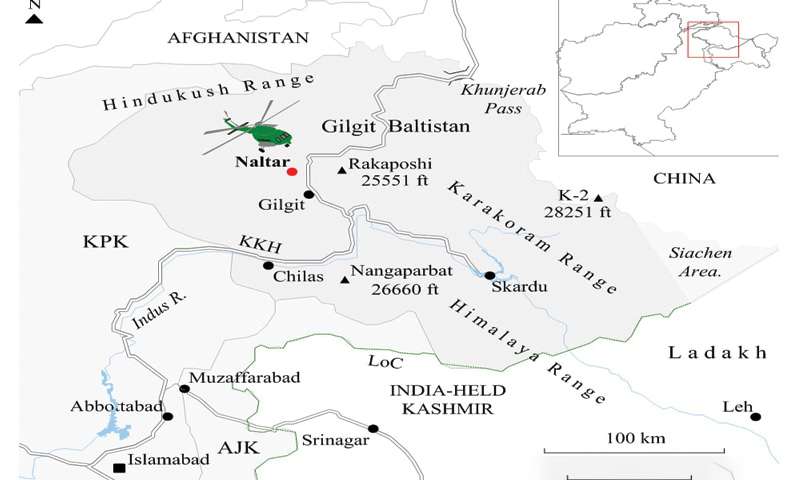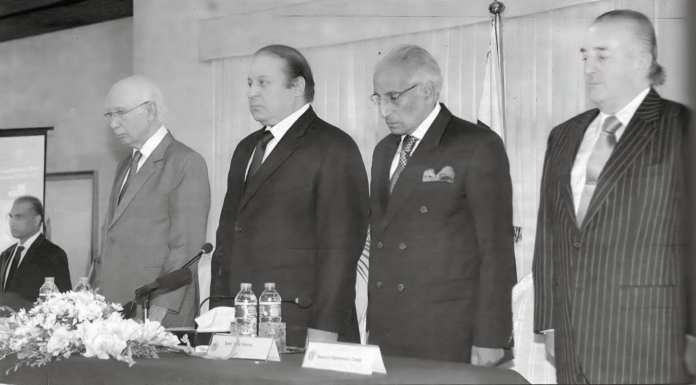Just when everything seemed to be coming good for Pakistan, the Army MI-17 crash in Naltar brought us literally and figuratively down to earth. What made this great tragedy different was that the Ambassadors of Norway and Philippines as well as the wives of the Malaysian and Indonesian Ambassadors, lost their lives. Several other Ambassadors and their wives were among those injured. The seven killed in the crash included the two pilots, Majors Altamash and Faisal. Both qualified VIP pilots, each had more than 10 years flying experience. The highly inflammable JP-4 fuel ignited an inferno that engulfed the aircraft after it crash-landed on the top of the Army Public School (APS). Classes were fortunately suspended for the day, schoolchildren among the casualties would have been horrendous.
Situated in a valley perched in the high Karakorams, the strong wind in Naltar creates a “wind tunnel” effect. Two MI-17s carrying VIPs for a PAF event landed earlier safely without encountering any problem. From eyewitnesses accounts as well as those from on board, in particular the High Commissioner of South Africa, the third (out of four) aircraft went out of control on “short finals”, i.e. very close to the landing zone at a low altitude, spiralling downwards because of the torque effect of the rotors. Other than the take-off stage, that is normally a most critical period while flying.
The loss of rudder control makes it prima facie seem a fault pertaining to the tail rotor. It could have experienced metal fatigue aggravated by the high wind, one cannot say with any certainty without the enquiry by aviation experts being complete. The burn injuries point to the fire being responsible for most casualties. Had it not been for the raw heroism of the soldiers and policemen on duty, risking life and limb to drag the injured out from the burning helicopter before the fire and smoke made it impossible, the casualty figure could have been much higher.
An upgraded version of the Russian-made MI-8, the MI-17 normally carries 26 passengers, 18-19 in VIP configuration. Manufactured by the Military Moscow Helicopter Plant in Moscow, the Kazan Helicopter Plant in Kazan and the Ulan-Ude Aviation Plant, more than 17,000 MI-8/Mi-17 helicopters have been produced, a world record for twin-engine helicopters. The most popular transport helicopter in the world in both civil and military versions. the MI-17 is used by more than 50 countries. The difference from the Mi-8 is that the tail rotor is mounted on the left side because of the more powerful engines. The basic cargo version can transport up to 4,000 kg of various kinds of cargo, either inside the cabin or on an external sling.
The host country being responsible to ensure their safety and comfort, deaths and injuries to the diplomats reflects very poorly on the image of the country. Being guests of the Govt of Pakistan added embarrassment to the catastrophe. One is personally anguished by the sad demise of HE Leif Larsen, the Norwegian Ambassador, who came to see me in Karachi barely a couple of months ago. The depth of this outstanding diplomat’s knowledge and understanding about Pakistan and the region, his insight about Karachi showed his deep commitment and dedication. Over lunch we discovered a common passion for the books of John Masters, he exhorted me to definitely read “Pilgrim Son – A Personal Odyssey”. Unfortunately John Masters’ books are mostly out of print and difficult to trace. One rarely finds diplomats of such stature and calibre as Leif Larsen, Norway should be proud to have had such a son like him, death be not proud!

Not many people realize that Pakistan’s Army Aviation has been continuously at war for nearly 16 years, starting from Kargil in 1999, without a break. Besides several dozen fixed wing L-19s and a few OH13(S) helicopters, Army Aviation’s inventory had only a dozen Alouette-3 or so and a similar number of MI-8s in 1970-1971, of MI-17s alone there are about 50 today. Having flown an Alouette-3 in the high mountains of Azad Kashmir and Gilgit-Baltistan extensively during peacetime in 1969 and 1970, I did many sorties in the Gilgit/Skardu area including quite a few to Naltar. Maj (later Maj Gen) HUK Niazi, SJ (later Chairman NHA) was the KKH Flight Commander. The flying was very intensive, because of shortage of pilots during cyclone relief operations in 1970/early 1971 in East Pakistan I flew only intermittently as a co-pilot on MI-8s but along with an Instructor Pilot not having done the MI-8 Conversion Course. In contrast to what we had to cope with one can only imagine the stress and strain on our magnificent Aviators flying combat missions on a continuing basis for more than a decade and half.
The nature of the ongoing war against terrorists and the conventional war likely to be and the widely varying terrain where the present (and the future wars) are likely to be fought, we must increase our heliborne capacity manifold. We are likely to induct Russian-made MI-35 helicopters, the US has gifted, among other equipment, 26 Bell 412 helicopters used in Afghanistan. We may also acquire some Chinese helicopters. Compared to today’s Aviators our flying was pretty basic. Besides the need for more and more pilots, there is no substitute to continuous and extensive training as well as regular flying. Notwithstanding superb maintenance standards, this varied inventory requires investing in training simulators for each aircraft type. Tail rotor failure can only be practiced on a simulator. The continuous flying has meant great wear and tear on the aviation manpower (pilots and engineering both) and the aircraft. The Naltar accident could have happened anywhere, however the Army needs to look after and increase the incentives for its pilots facing combat situation on a daily basis. For them extensive flying during periodic earthquakes and floods are only interruptions in continuous combat operations.
Kudos to the Army and PAF for making sure that the survivors were looked after in exemplary fashion. The govt must be commended for ensuring honour to the dead and injured with grace and heartfelt homage. The country’s image may have taken a hit but the solemn and superb manner the nation cared for the diplomats of many nations in their hour of grief will go a long way in mitigating the terrible tragedy. What crossed the fail-safe line of stress and strain on the pilots and/or the machine is still matter of conjecture, with accidents come grief. This terrible tragedy transformed beautiful Naltar in a few minutes of absolute horror into a valley of death.




